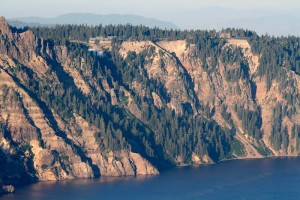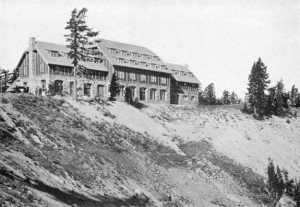Spiraling costs forced Parkhurst to find savings elsewhere in the project. When the lodge opened in the summer of 1915, the furnishings seemed spartan. Exterior walls were clad in tar paper. Interior walls of the guest rooms were finished with thin cardboard-like “beaver board.” There were no private bathrooms, and a small generator provided electricity.
Although business profits lagged due to high operational costs, Crater Lake Lodge drew large crowds. Early 20th century visitors probably accepted the substandard accommodations because of the rigorous trip needed to reach the park. Though the lodge lacked amenities and atmosphere, visitors were compensated by the magnificent views of Crater Lake and the surrounding peaks of the Cascade Range.

When it was enlarged and upgraded from 1922 through 1924, the number of guest rooms more than doubled. Plumbing was expanded, and as a result most of the rooms in the new annex and annex wing had private bathrooms. However, a lack of investment capital plagued the expansion. Many guest rooms were left unfinished. The lodge suffered with the decline in visitation and business during the early 1930s, the worst years of the Great Depression. Little was spent to keep up the facility. It was not until the mid 1930s that guest rooms on the second and third floors of the annexes were finished. The lodge was situated in a barren and very dusty environment. Cars had destroyed most of the surrounding vegetation.
One of the great improvements made during the 1930s was the development of a landscape for Rim Village which included plantings around Crater Lake Lodge. In contrast to the privately funded hotel, this publicly funded project was accomplished by the National Park Service and the Civilian Conservation Corps. The new landscape included hundreds of indigenous trees and shrubs, and helped to blend the structure into its surroundings. As part of the project, new paved parking areas and walkways were built adjacent to the lodge. This significantly reduced the blowing dust and erosion problems around the building and gave the area a more “natural” appearance.


